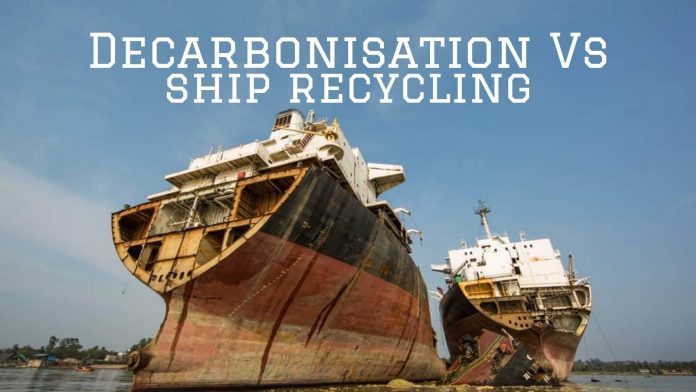
Decarbonisation and shipping: ship recycling – a changing landscape
As the drive to decarbonise shipping gains increasing momentum, and as incentives and pressure on shipowners to operate more efficient and greener ships mounts, a related spike in early retirement of ships difficult to decarbonise and which are losing favour in the market, may result. Consequently, decarbonisation of shipping may drive a boom in ship disposal. But would this support or detract from the overarching goal of reducing damaging impact to the environment and climate?
In this article we consider the past and ongoing environmental issues surrounding ship disposal, provide a summary of the main regulations which seek to address these problems and take a look at the emerging landscape of ship recycling as a life-cycle consideration and not just an end-of-life concern.
We also consider the implications of recent action against owners and buyers, as was the case in the Tide Carrier, North Sea Producer and the Dutch case involving Seatrade which suggests that courts and regulators are taking a closer look at the practices around end-of-life vessels.

Environmental concerns
Ships are large objects that cannot easily be ‘thrown away’. Historically, ships at the end of their ocean-going lives have tended to be either repurposed (for example as storage units, prisons or nightclubs), abandoned, sunk or broken up and then disposed of in smaller parts, some of which may be recycled.
When compared to sinking or abandonment of old ships, shipbreaking and recycling is by far the most environmentally-friendly and economically sound option, as it ensures proper management of hazardous material and the reuse of valuable resources such as steel, iron, aluminium and plastics. Unfortunately, only a small percentage of shipbreaking operations are handled in a safe and clean manner. Shipbreaking is a heavy and hazardous industry that exposes workers and the environment to a number of risks, for instance workers are often required to work at height or in confined spaces, with little or no PPE, and ship structures contain numerous toxic materials such as asbestos, PCBs, oil residues, organic waste, heavy metals, and toxic paints.
In 2017, according to the NGO Shipbreaking Platform, 543 ships, representing 80 percent of the world’s end-of-life tonnage, were broken under rudimentary and sub-standard conditions on the beaches of Alang in India, Chittagong in Bangladesh and Gadani in Pakistan.
Studies in some of these areas have shown that the pollution caused by shipbreaking can negatively impact local ecosystems due to the increased presence of heavy metals and micro-plastics. For example, the studies observed increased numbers of harmful bacteria and reduced ecologically important organisms such as zooplankton. Furthermore, other studies showed that exposure to the various pollutants found in these environments, including asbestos, risked the health of workers.
Transforming hazardous shipbreaking into sustainable ship recycling necessitates:
- shipowners selling their ships to breakers that invest in their operations’ safety and environmental standards;
- moving shipbreaking away from beaches and onto quaysides and dry-docks in appropriate areas, with the ability to store and handle the waste in a safe manner; and
- focusing on green ship design at the outset, reducing hazardous materials in newbuilds and minimising waste at the end-of-life stage by planning for future efficient dismantling.
However, there are concerns as to how the implementation of green measures would affect the costs of building, operating and eventually dismantling a ship where substandard and cheaper options are still available. As a result, there has been a reluctance in the current market to adopt more sustainable methods.
While costs implications associated with green ship disposal are a consideration for shipowners, recent case law has shown that international and national courts, as well as environmental authorities, are prepared to examine the practices used by shipowners when scrapping a vessel and to enquire whether ship recycling regulations have been complied with. It has also become clear that authorities are prepared to look back at the decision-making process upon the sale of a vessel to be disposed of, and to assess whether any breaches of regulations have occurred. Consequently, the risk of regulatory breaches, which could result in heavy fines and reputational damage, should also be at the forefront of a ship owner’s approach to ship disposal and act as a further incentive to choose greener options.
In view of the risk of prosecution for failing to adhere to ship recycling regulations, ship owners are increasingly advised to conduct appropriate environmental and social due diligence on the yards used for ship disposal, and to adopt a more informed approach in relation to who is buying their vessel, where it will be recycled and whether there will be repercussions to the environment and people.
Shipowners therefore now need to navigate a stricter approach to an already complex set of rules and regulations than in the past.

Regulations overview
Ship recycling regulations have been implemented over time to negate the detrimental effects of ship dismantling and include the following regulations.
Basel Convention and The Basel Convention Ban Amendment
In 1989, the United Nations Environmental Program adopted the Basel Convention on the Control of Transboundary Movements of Hazardous Wastes and their Disposal, following numerous hazardous waste trafficking incidents, which came into force in 1992. The Basel Convention is relevant in the context of ship dismantling, as ships that have reached their end of life contain hazardous materials in their structures. The Basel Convention requires ship wastes to be managed and disposed of in an environmentally friendly way and to minimise the transportation of such wastes. The Ban Amendment entered into force in December 2019 and prohibits the export of hazardous wastes from Organisation for Economic Cooperation and Development (OECD) countries and Liechtenstein, to all non-OECD countries.
Hong Kong Convention
The International Maritime Organization (IMO) Hong Kong International Convention for the Safe and Environmentally Sound Recycling of Ships (HKC) was adopted in May 2009. The HKC seeks to ensure that the various stages of a vessel’s life, from construction to recycling, are performed in a safe and environmentally conscious manner. Key requirements of the HKC are that ships carry an inventory of hazardous materials and ship recycling facilities provide a ship recycling plan. However, the HKC has yet to enter into force and will not do so until 24 months after ratification by 15 states, representing 40 percent of world merchant shipping by gross tonnage, have signed it. At present, these requirements have yet to be met.
European Union Waste Shipment Regulation
The European Union Waste Shipment Regulation (EC) No 1013/2006 (EU WSR) transposes the Basel Convention and the Basel Ban Amendment into European Union law. It imposes a set of controls for the shipment of waste within, to and from the EU and imposes a procedure for waste shipment depending on the shipment’s destination, the type of waste and manner in which the waste will be processed after shipment.
On 1 January 2021, in a move to bring an end to the export of plastic waste to third countries that lack the resources to manage that waste sustainably, the EU brought into force the EU Commission Delegated Regulation (EU) 2020/2174, amending the EU WSR to include plastic waste. Regulation (EU) 2020/2174 seeks to ban the export of plastic waste, except for clean plastic waste, from the EU to non-OECD countries. As many components of ships are plastic, these Regulations apply to the disposal of ships.
European Union Ship Recycling Regulation
The European Union Ship Recycling Regulation (EU) No 1257/2013 (EU SSR) entered into force on 30 December 2013 and as from 31 December 2020 the EU SRR is now fully implemented. It is the only legal framework in force dedicated to regulating ship recycling. The EU SSR sets requirements for ship recycling facilities to ensure that ship dismantling is performed in an environmentally acceptable manner. It also restricts the use of hazardous materials on ships, and maintains a list of approved ship recycling facilities. While the EU SSR largely reflects the requirements of the HKC, it also includes additional safety, environmental and occupational health and safety standards that go beyond the HKC.
UK Ship Recycling Regulations
The UK Ship Recycling Regulations (UK SRR) give domestic effect to the EU SRR and apply to all UK ships, excluding ships of less than 500GT and UK ships operating throughout their life in UK waters only. If a UK ship operating throughout its life in UK waters only goes to a recycling facility in an EU member state, the EU-SRR will apply.
Ship recycling initiatives and the way forward
As will be noted from the above summary, the industry lacks a global regulation that would create a uniform and level playing field for all involved in the decommissioning of vessels, and would also make compliance less of a challenge This, coupled with the fact that regulators are now prepared to investigate and enforce financial and criminal penalties, means that shipowners need to conduct enhanced due diligence in relation to where they will dispose of their ships and to ensure strict compliance of ship recycling regulations.
In order to combat this lacuna, and as has also occurred in the decarbonisation space, industry players have stepped up with their own solutions to encourage and support the performance of ship dismantling in an environmental and socially conscious manner. The Ship Recycling Transparency Initiative (SRTI) has been set up to enable shipowners to share data on ship recycling policies, to demonstrate a commitment to transparency and responsible ship recycling practices. Many shipowners and other shipping organisations have also become signatories to the Sustainable Shipping Initiative (SSI) which seeks to improve the overall sustainability of the shipping industry, including ship recycling transparency. Initiatives such as the above enable cargo owners, lenders and other stakeholders to make informed decisions, allowing them to point to a more accountable supply chain and reward good practice. Further, a number of banks have signed the Responsible Ship Recycling Standard (RSRS) to encourage sustainable ship recycling practices and Clubs have also developed ship recycling cover to assist shipowners with the recycling costs.
Shipowners have also begun to develop and implement green recycling policies and have looked to incorporate contractual provisions in ship sale agreements to ensure that a sale leads to the recycling of the ship in an environmentally safe way, thereby raising the bar for other shipowners and industry players to also implement and adhere to green ship recycling policies and practices.
Together with the regulatory framework, national and international enforcement of regulations, and the above-mentioned industry initiatives, has resulted in a heightened focus on ship recycling globally which has led to the scrutinising of existing ship recycling policies and practices. Shipowners are becoming aware of the need to take a more holistic approach to ensuring their vessels and practices are sustainable for the environment and people. This will no doubt have a knock-on effect on those industry players who have yet to incorporate sustainable practices.
It is clear that legislation and the willingness of authorities to investigate a sale of a ship which is destined for recycling and look at the decisions taken at the time, has placed a heavier burden on shipowners to ensure that the eventual recycling of their ship complies with the applicable regulations. However, while such regulations have come some way from their initial inception in ensuring that environmentally friendly ship recycling measures are in place, the lack of a harmonised set of regulations has meant that varying recycling standards are applied between nations. The uneven legislative playing field has made it difficult for shipowners to ensure compliance and has also allowed for sub-standard facilities to continue to operate in some parts of the world.
Green shipping requires a continuous assessment of a vessel’s environmental impacts throughout its life – from the building phase, its operational maintenance, right through to its eventual scrapping and recycling. Similar to decarbonisation, ship recycling is increasingly an area which requires lifecycle consideration, and is not just a concern which arises when a vessel has reached its end of life.
Source : Daily Maritime News
